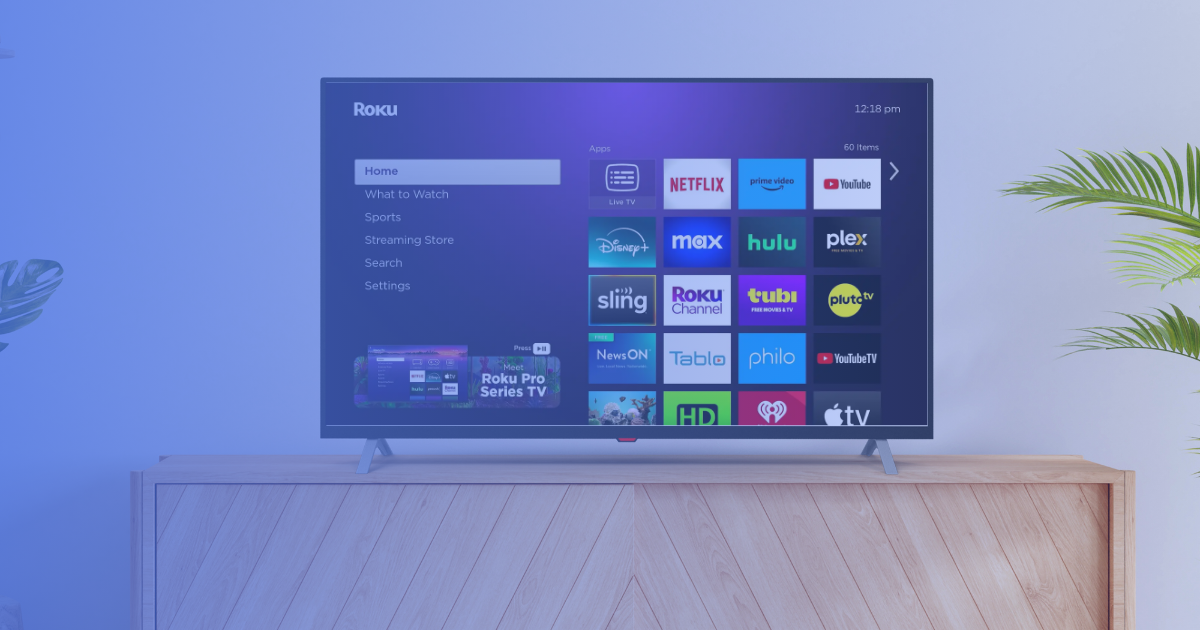Connected TV wrapped: 2024 highlights and 2025 predictions.
In 2024, streaming viewership surged, ad-supported models thrived, and programmatic took over. As we head into 2025, Connected TV is poised for even greater growth.

January 7
Share this blog:
Your CTV Wrapped has arrived! As we bid farewell to 2024, let’s take a moment to celebrate the evolution of Connected TV (CTV)—with a nod to one of our favorite audio advertising partners, Spotify.
This year, CTV reshaped how we consume content and interact with ads. From the explosive growth of streaming viewership to the widespread adoption of ad-supported models and breakthroughs in programmatic advertising, 2024 has been a pivotal year for both viewers and advertisers.
Let’s rewind the biggest moments of 2024 and take a bold look ahead at what’s in store for 2025 and beyond.
Streaming still reigning supreme.
Streaming continues to hold the throne for TV viewing, accounting for 41.6% of total TV viewing time in the end of 2024. That’s a 7.6% increase from last year, leaving cable (25.0%) and broadcast (23.7%) in its digital dust. It’s clear that consumers are increasingly preferring what streaming has to offer, even with an Olympic and election year that was predicted to slow growth.
Ad revenue breaks the billion-dollar barrier.
Streaming platforms are proving the value of ad-supported models, with Peacock, Netflix, Roku, Amazon, YouTube, and Hulu all hitting the billion-dollar ad revenue mark in 2024. This shift highlights the growing importance of these models, balancing affordability for viewers with strong returns for platforms.
CTV got with the program.
By the end of 2024, programmatic advertising now accounts for about 75% of all CTV transactions. This rise is thanks to innovations like clean rooms, data partnerships, and the increasing need for cross-platform data. This means advertisers are finally taking advantage of CTV’s digital features, exclusively targeting their ideal audiences on their terms and creating hyper cost-effective campaigns.
Viewer habits are near pandemic level highs.
- More Time on the Couch: Viewers are spending 5% more time watching content each day than they did last year. Looks like binge-watching isn’t just a phase.
- Longer Sessions, More Connection: Average session lengths have increased by 7%, meaning longer form content is here to stay. Viewers are in it for the long haul.
- Better Retention: Churn rates are slowly declining, which is a win for platforms working to keep their audience interested month over month.
Ads: Balancing act.
Ad loads, or the number of ads per hour, have slightly declined, dropping 3.4% from 9.4 minutes in 2023 to 9.1 minutes in 2024. Platforms like Netflix and Max are keeping things light, allowing for higher CPMs while still delivering a pleasant viewing experience. Meanwhile, Paramount+ is taking a different approach, with ad volumes comparable to those found on FAST (Free Ad-Supported Streaming TV) channels. It’s all about striking the right balance.
The supply-and-demand showdown.
Ad fill rates (the proportion of available ad inventory that’s successfully filled with advertisements) took a dip in 2024, largely due to a flood of ad supply. Amazon alone added 50 billion ad impressions, flooding the market and putting pressure on CPMs. It’s a competitive scene, and platforms’ CPMs are dropping to stay attractive.
As the streaming landscape continues to evolve, 2025 is shaping up to be another big year. Here’s what we predict:
Ad revenue growth isn’t stopping.
CTV ad spend is set to reach $34.3 billion in 2025, up from $29 billion in 2024. By 2026, nine platforms will join the billion-dollar club, with Disney+, Tubi, and Pluto TV projected to round out the elite group.
More smaller brands will welcome CTV.
CTV advertising is no longer just for the big brands. With affordability and precision at its core, more small-to-mid-sized brands will be jumping into streaming and able to generate performance on budgets half the size of traditional TV.
Flexibility will be key.
To keep churn rates down and satisfaction high, platforms are likely to roll out new pricing tiers, bundling options, and loyalty programs. It’s all about keeping things flexible to reduce subscriber dropout while maximizing profits.
The OS wars heat up.
2025 will see the TV operating system (OS) take center stage in the CTV ecosystem. Walmart’s acquisition of Vizio and The Trade Desk’s launch of a neutral OS will create new opportunities and challenges for advertisers. The battle for supremacy among TV OSs is about to get interesting.
FAST channels: more for less.
By 2030, all major SVOD platforms—including Apple TV+, Disney+, and Netflix—are expected to incorporate FAST channels. These ad-supported channels will help platforms monetize older content while keeping subscribers engaged. More content, more ads—everyone wins.
Consolidation: It’s getting crowded.
With so many streaming options, consolidation is inevitable. Consumers are overwhelmed by apps, and advertisers are looking for more efficient ways to access audiences. Expect to see more partnerships, acquisitions, and bundling as platforms scramble to stay relevant in this crowded market.
Streaming apps will embrace programmatic.
While many streaming apps now offer ad-supported tiers, some still lack programmatic advertising capabilities, limiting advertisers to broad, untargeted campaigns reminiscent of traditional TV. By 2025, we expect more of these “new-to-ad” apps to embrace programmatic advertising by integrating with DSPs and SSPs, enabling data-driven audience targeting.
Time spent vs. ad spend: The opportunity gap.
CTV will capture 20% of daily media time by 2026, but will only account for 8.1% of total ad spend. This gap represents a huge opportunity for advertisers to align budgets with consumer behavior. If you’re not investing in CTV now, you are missing out.
2024 was a year of major shifts in the CTV landscape, but 2025 promises even bigger things. With more inventory and larger audiences than ever, streaming presents unparalleled opportunities—but also new challenges like fraud and misinformation. The next era of TV will be smarter, more connected, and more competitive. And for advertisers, the key to success will be staying informed and ahead of an exploding space.
The race to capture attention on the biggest screen in the house is only just beginning— partner with a company that’s been leading the charge from day one.
Join the EMG mailing list.
Stay connected with EMG and get the latest posts delivered straight to your inbox.
EMG will handle your data pursuant to its Privacy Policy.
Ready to get started?
Learn how EMG drives measurable market share growth for dealerships.
Recent blogs.
View all blogsCopyright © 2025. All Right Reserved




